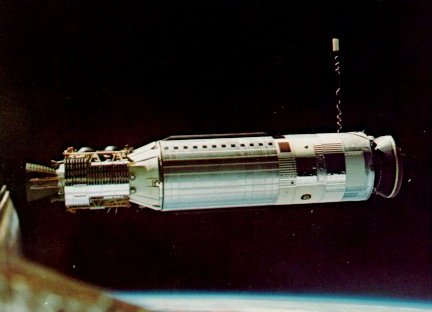Time Travel Research Center © 2005 Cetin BAL - GSM:+90 05366063183 - Turkey/Denizli
Apollo Expeditions to the Moon
CHAPTER 1
THE PLAN IN RETROSPECT
In thinking back over the flights of Apollo, I am impressed at the
intrinsic excellence of the plan that had evolved. I have, of course,
somewhat oversimplified its evolution, and there were times when we became
discouraced, and when it seemed that the sheer scope of the task would
overwhelm us in some areas there were surprises and other areas proceeded
quite naturally and smoothly.
 |
Gemini launches drew hundreds of thousands of spectators, awed by the roar, flame, and smoke of the big Titan II booster. Viewers clogged the highways and camped by roadsides. Millions of others watched launchings an television, and the astronauts received tumultuous welcomes on their return. The launch at left is Gemini V, which carried Astronauts Cooper and Conrad for 120 revolutions of the Earth during August 1965. Fuel cells had their first space test an this flight. |
 |
| First U.S. rendezvous in space occurred an December 15, 1965, when Gemini VI found and came within 6 feet of Gemini VIl, which had been launched 11 days earlier. Picture below was shot by Tom Stafford, aboard Gemini VI with Wolly Schirra. The other spacecraft, shown here at a range of 37 feet, was flown by astronauts Borman and Lovell in a flight lasting more than 330 hours. Rendezvous proved entirely feasible but tricky to manage with minimum fuel use. |
The most cruel surprise in the program was the loss of three astronauts in
the Apollo fire, which occurred before our first manned flight. It was
difficult for the country to understand how this could have occurred, and it
seemed for a time that the program might not survive. I believe that the
self-imposed discipline that resulted, and the ever-greater efforts on
quality, enhanced our chances for success, coming as they did while the
spacecraft was being rebuilt and final plans formulated.
The pogo problem was another surprise. Like the fire, it showed how
dif'ficult it was to conquer this new ocean of space. Fortunately, intensive
and brilliant work with the big Saturns solved the problem with the launch
rocket, permitting the flights to proceed without mishap.
 |
| Astronaut Edward H. White was the first American to step outside in space. Jim McDivitt, Gemini IV's command pilot, took this picture on June 3, 1965. A 25-foot umbilical line and tether linked White to the spacecraft. In his left hand is an experimental personal propulsion unit. His chest pack contained an eight-minute emergency oxygen supply, as a backstop. |
 |
| An Agena target vehicle was docked with by Gemini VIll on March 16, 1966. A short-circuited thruster set the two craft spinning dangerously, forcing Astronauts Armstrong and Scott to end the mission. |
We had planned a buildup of our flights, starting with a simple Earth-orbit
flight of the command and service modules (Apollo 7), to be followed by
similar trials with the lunar module (LM) added, for tests of rendezvous and
docking and various burns of the LM engines (Apollo 9). These tests would
have then been followed by flights to Lunar orbit with the LM scouting the
landing but not going all the way in (Apollo 10), and then the landing (Apollo
11).
After Apollo 7, however, the LM was not yet ready and the opportunity
occurred to fly to the Moon with command and service module (CSM) only. This
flight (Apollo 8) was to give us many benefits early in the progam.
Technically, it gave us information on our communication and tracking
equipment for later missions, a close view of our landing sites, and
experience in cislunar space with a simplified mission. Politically, it may
have assured us of being first to the Moon, since the stepped-up schedule
precluded the Russians from flying a man around the Moon with their Zond
before we reached the Moon following our previously scheduled missions.
The flights came off almost routinely following Apollo 8 on through the
first lunar landing and the flight to the Surveyor crater. But Apollo 13 was
to see our first major inflight emergency when an explosion in the service
module cut off the oxygen supply to the command module. Fortunately, the LM
was docked to the CSM, and its oxygen and electric power, as well as its
propulsion rocket, were available. During the 4-day ordeal of Apollo 13, the
world watched breathlessly while the LM pushed the stricken command module
around the Moon and back to Earth. Precarious though it was, Apollo 13
showed the merit of having separate spacecraft modules, and of training of
flight and gound crews to adapt to emergency. The ability of the flight
directors on the ground to read out the status of flight equipment, and the
training of astronauts to meet emergencies, paid off on this mission.
Apollo surely is a prototype for explorations of the future when we again
send men into space to build a base on the Moon or to explore even farther
away from Earth.